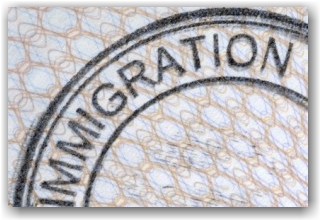Posts Tagged ‘USCIS’
Sunday, December 30th, 2012

As 2012 winds down, with year-end planning sessions and budget meetings for 2013, how would you rate your company’s employment eligibility compliance program, as it stands right now? We are not in the bubble bursting business, but we’ve yet to see a compliance program that doesn’t need some upgrading and refinement – no one’s is perfect.
According to new data from ICE, since 2007, employer I-9 audits have increased from 250 to more than 3,000 in 2012. From fiscal years 2009 to 2012, the total amount of fines grew to nearly $13 million from $1 million. Statistics released by ICE in July 2012 stated that overall, $87.9 Million in fines have been imposed on employers for violations. The number of company managers arrested has increased to 238. Widespread employer audits will continue to increase this year. Plain and simple, failing to comply with IRCA’s I-9 rules will continue at a rapid rate, resulting in significant fines, loss of access to government contracts, an onslaught of negative publicity, business closure, criminal penalties and imprisonment.
With all the advice, blogs and articles written about the most complicated 1-page form on the planet, there are some basics – a simple formula that, if implemented, followed and maintained, will greatly enhance your level of I-9 compliance and reflect your company’s genuine desire to get its compliance house in order. This is what we recommend:
- Invest in a comprehensive I-9 audit by a knowledgeable attorney or professional who actually practices in this area of the law. Don’t engage in a self-audit without participating in a thorough training program first. This will cause more harm than good; it’s like the blind leading the blind.
- Following the audit and the review of your report of findings, get trained before the correction process begins. Who should be trained? All those who have hands-on exposure to the I-9 process at all of your organization’s locations…and all those who supervise the process and staff. Make training and reading the M-274 Employer Manual absolute requirements for those assigned to I-9 processing and management.
- Establish a written Compliance Policy. This does not need to be a huge undertaking, but should reflect your company policy concerning the steps you’ve taken to assure a compliant workforce and a culture of compliance at your organization. It will be your road map and reflects that you take compliance seriously. ICE will request this document, amongst many others, should they ever come knocking on your door.
- Appoint a Compliance Guru – one who has a senior level of knowledge, who will monitor your internal compliance program, review your I-9 forms every few months for accuracy and completeness, provide updates and arrange for refresher training on a yearly basis.
- Consult with a trusted professional in the field when questions or challenges arise – don’t guess.
Remember, the key to defending any employment related investigation is to evidence that there is and has been a consistent pattern of responsible, good faith effort on the part of the employer in establishing a compliant workforce. Stay informed, subscribe to our Blog, newsletter, and join in the conversation on our LinkedIn Group I-9/E-Verify: Smart Solutions for Employers. Check out our compliance services and solutions here, and make a concerted effort this year to increase your level of compliance by following the above formula.
Tags: Compliance Policy, E-Verify, Employment Eligibility Verification, I-9 AUDIT, I-9 Form, I-9 Immigration Compliance, I-9 Training, I-9/E-Verify News, ICE, ICE Audit, Immigration compliance, Immigration News, Legal Workforce, Mandatory E-Verify, USCIS
Posted in Comprehensive Immigration Reform, Employer Compliance, I-9/E-Verify News, ICE, Immigration Legislation, Immigration News, OSC, USCIS | Comments Off on I-9/E-Verify: 2013 Compliance Considerations for Employers
Wednesday, December 12th, 2012

The E-Verify home page of the USCIS website has posted news updates for your information, as follows:
1) Florida is the newest state to join the Records and Information from DMVs for E-Verify (RIDE) Program. E-Verify is now checking driver’s licenses and ID cards from the state of Florida when presented as a List B document for I-9 purposes. On June 13, 2011, USCIS launched RIDE. This feature allows the E-Verify Program to validate the authenticity of driver’s licenses presented by employees as Form I-9 identity documents. Mississippi was the first state to partner with USCIS to implement RIDE.
2) E-Verify has redesigned Questions and Answers. The new Questions and Answers provide information to current participants that specifically relates to their role with E-Verify and important topics that may affect their organization. In addition, this new resource includes frequently asked questions and information that is needed before you enroll in E-Verify.
3) Please sign up for the new Employee Rights Webinar for Worker Advocates.
For more information, please refer to our Employer Resource Center and sign up to receive our compliance news, updates and blog posts here
Tags: E-Verify News, E-Verify Updates, Employment Eligibility Verification, FL dirver's license and ID cards, I-9 Form, I-9 Trainining, I-9/E-Verify News, Legal Workforce, USCIS, What's New with E-Verify
Posted in I-9/E-Verify News, ICE, Immigration News, OSC | Comments Off on E-Verify…What’s New
Thursday, November 29th, 2012
 Much of the immigration challenges around case approval for entrepreneur start ups with USCIS has to do with the cases being reviewed by untrained officers, a lack of overall guidance for attorneys and practitioners concerning this casework, and a fundamental lack of “real world”, hands-on business knowledge on the part of USCIS. The agency has definitely released a nice looking mini-website marketing piece on the subject. We remain hopeful that the implementation of the below-listed changes will be the start of a new mindset for USCIS adjudication of entrepreneur start-up casework. In reviewing the information, we note that the Entrepreneur in Residence (EIR) team states that they have:
Much of the immigration challenges around case approval for entrepreneur start ups with USCIS has to do with the cases being reviewed by untrained officers, a lack of overall guidance for attorneys and practitioners concerning this casework, and a fundamental lack of “real world”, hands-on business knowledge on the part of USCIS. The agency has definitely released a nice looking mini-website marketing piece on the subject. We remain hopeful that the implementation of the below-listed changes will be the start of a new mindset for USCIS adjudication of entrepreneur start-up casework. In reviewing the information, we note that the Entrepreneur in Residence (EIR) team states that they have:
– Developed and deployed a training workshop for USCIS employment-based immigration officers that focuses on start up businesses and the environment for early-stage innovations;
– Trained a team of specialized immigration officers to handle entrepreneur and start up cases;
– Modified Request for Evidence templates for certain nonimmigrant visa categories to incorporate new types of relevant evidence into the adjudicative process; and
– Developed a plan for quarterly engagements with the entrepreneurial community to ensure that USCIS stays current with industry practices.
To sustain the momentum and build on the team’s accomplishments, USCIS indicated that they have extended the EIR project through April 2013. The project should be extended indefinitely if we are seriously courting foreign entrepreneurs to help jump-start the US economy. Among other things, the team states that it will expand its focus to immigrant visa pathways that may enable foreign entrepreneurs to start a business in the United States within current immigration law.
We are hopeful, in light of the economic challenges ahead of us in the USA at this time, that Congress will have a light bulb moment and pass legislation for a Start-up Visa and find a balanced and fair approach to increasing the visa alotment for STEM occupations without the punitive tradeoff approach of penalizing other visa classifications in return. For more information on the EIR program, we link here.
Tags: Congress, E-2 Visa, EB-5 Individual Visa, EB=5 Regional Center, Entrepreneurs in Residence, Foreign Entrepreneurs, Foreign Investors, H-1B Visa, Immigration Legislation, Immigration Reform, Job Creators, Start-up Visa, USCIS
Posted in Comprehensive Immigration Reform, Congress, Global Immigration, H-1B Visas, Immigration Legislation, Immigration News, L-1 Visa, USCIS | Comments Off on USCIS Develops Tools to Help Foreign Entrepreneurs Create and Grow Businesses in the USA
Monday, November 19th, 2012
 USCIS released I-9 instructions to employers today regarding how to fill out the I-9 form for new and existing DACA employees. There have been many questions and speculations concerning how to handle the Form I-9 with existing employees; thus, this guidance is certainly welcomed. We would advise you to print out the instructions and keep them for reference and attach them to either your I-9 reverifications or your new I-9 forms (whichever is appropriate based upon the instructions) for existing DACA employees.
USCIS released I-9 instructions to employers today regarding how to fill out the I-9 form for new and existing DACA employees. There have been many questions and speculations concerning how to handle the Form I-9 with existing employees; thus, this guidance is certainly welcomed. We would advise you to print out the instructions and keep them for reference and attach them to either your I-9 reverifications or your new I-9 forms (whichever is appropriate based upon the instructions) for existing DACA employees.
Please note also that the DACA website has been updated with new FAQ’s, instructions offered in various languages and Filing Tips.
To review, the DACA initiative offers a two year grant of reprieve from deportation as well as work authorization for unauthorized immigrants who were under the age of 31 as of June 15, 2012 and who can demonstrate that they meet the following criteria:
• Entered the United States before the age of 16
• Have continuously resided in the United States since June 15, 2007 and up to
the present time, and were physically present on June 15, 2012 and at the time
of application
• Are currently in school, have graduated from high school or earned a GED, or
are honorably discharged veterans of the US armed forces (including the Coast
Guard)
• Have not been convicted of a felony, significant misdemeanor, or three or more
misdemeanors; or otherwise pose a threat to public safety or national security
• Entered the country illegally or overstayed their visa prior to June 15, 2012.
You might wish to refer to our previous blog post on DACA and sign up to receive our free newsletters, blog posts and I-9 information and updates.
Tags: DACA, Deferred Action, EAD, Employment Eligibility Verification, I-9 Form, I-9/E-Verify News, Immigraiton Compliance Group, Legal Workforce, USCIS
Posted in Uncategorized | Comments Off on I-9/E-Verify News: USCIS Issues I-9 Guidance to Employers for DACA Employees
Monday, September 17th, 2012
 On Sept. 16, 2012, E-Verify provided several enhancements to improve your experience with the program. We particularly like these new features:
On Sept. 16, 2012, E-Verify provided several enhancements to improve your experience with the program. We particularly like these new features:
- For Corporate Administrators: A new Web-based tutorial replaces the live webinar training required of new Corporate Administrators. The tutorial also serves as a resource for existing Corporate Administrators. To access the E-Verify Tutorial for Corporate Administrators, select the ‘Take Tutorial’ link under My Resources in the left-hand navigation menu.
- A new E-Verify User Manual for Corporate Administrators is now available from the ‘View User Manual’ link under My Resources in the left-hand navigation menu.
- They have also come up with a process for HR’s who must record the foreign passport and I-94 arrival-departure card (that can now take up to 45 days to access) in E-Verify
Should you wish to sign up for USCIS’ free E-Verify training, they have several monthly sessions. You can access their training schedule here.
By the way, the program is now compatible with Firefox, Chrome and Safari.
Tags: E-Verify Corporate Administrators, E-Verify Enhancements, E-Verify Training, Employment Verification, I-9 Form, I-9/E-Verify News, Immigration News, Legal Workforce, USCIS
Posted in Employer Compliance, I-9/E-Verify News, ICE, Immigration News, USCIS | Comments Off on E-Verify Releases New Enhancements
Friday, September 7th, 2012
The Department of Homeland Security issued an update today that the Department of Homeland Security (DHS) is working to resolve this issue and will have a fix on September 14, 2012.
:::::::::::::::::::::::::::::
Without any advance notice, the CBP has made changes that affect the I-9 form by no longer issuing paper I-94 cards and no longer stamping I-20 forms for F and M student visas, or form DS-2019 Certificate of Eligibility for Exchange Visitors and Foreign Students, affecting both J and F visa holders.
Customs and Border Protection is in the process of automating traveler arrival records (I-94 cards) to streamline passenger processing. The current processing time for entering foreign visitors’ travel information into the I-94 database is 30 days or more. This does not affect the majority of foreign travelers visiting for business or leisure and will not affect any visitor’s record of departure. But it will greatly influence how you document Section 2 of the I-9 form for the nonimmigrant employee that produces a List A foreign passport with an I-94 entry card.
PLEASE NOTE: With the newly proposed 2-page I-9 form, no guidance has as yet been provided regarding the I-94 card as an acceptable List A document in concert with a foreign passport. We will keep you posted concerning these changes as soon as we receive new guidance. In the meantime, we recommend that you print out this information and attach it to any new employee’s I-9 form who would normally produce an I-94 record (but doesn’t have one and is waiting to access an electronic version) along with a foreign passport as a List A document.
CBP has suggested the following: Nomiggrants may need to prove their legal-visitor status within the first 30-45 days of their U.S. stay to:
Employers;
Motor vehicle registration or drivers’ licensing agencies;
The Social Security Administration;
U.S. Citizenship and Immigration Services; or
Universities and schools.
If during this timeframe, visitors need to provide evidence of legal status they should include the following:
Unexpired foreign passport; and
Country of Citizenship
CBP Arrival/Departure Record, Form I-94 (if issued)
Contact CBP for more information or with questions.
Tel: (877) CBP-5511
TTD: (866) 880-6582
If a state benefit granting agency rejects an unstamped Form I-20/DS-2019, applicants may make an appointment with USCIS online through InfoPass and take their Form I-20/DS-2019 to their local USCIS office to be stamped. ( InfoPass ) This transitional step will end on Nov. 21, 2012.
International students and scholars who encounter issues with their state or federal benefit applications should continue to contact the Immigration and Customs Enforcement Student and Exchange Visitor Program (SEVP) at (703) 603-3400 or SEVP@dhs.gov.
Please feel free to contact our office should you have questions concerning these changes, 562 612.3996 or email info@immigrationcompliancegroup.com
Tags: CBP, DS-2019 form, Electronic I-94 card, F Visa, I-9 Form, I-9/E-Verify News, I-94 Card, ICE, Immigration News, J Visa, Legal Workforce, M Visa, New I-9 Form, Student Visas, USCIS
Posted in Customs & Border Protection(CBP), Employer Compliance, I-9/E-Verify News, ICE, Immigration Legislation, Immigration News, USCIS | Comments Off on Update: CBP Makes Changes Affecting I-9 Form, F, M and J Visa Stamping
Tuesday, August 7th, 2012
By: Timothy Sutton, Communications Editor
 The United States Citizenship and Immigration Services (USCIS) have released a brochure, flyer, information on avoiding scams and hosted a teleconference regarding the launch date of the Deferred Action Childhood Arrivals (DACA) Application effective August 15, 2012. USCIS has provided a wealth of detailed information in various forms to clarify the deferred action application procedures. The popular media format of the flyer will likely be the most effective educational tool used with those eligible for the program. The timeline format and accompanying info-graphics are matched with concise language that aid the reader’s understanding.
The United States Citizenship and Immigration Services (USCIS) have released a brochure, flyer, information on avoiding scams and hosted a teleconference regarding the launch date of the Deferred Action Childhood Arrivals (DACA) Application effective August 15, 2012. USCIS has provided a wealth of detailed information in various forms to clarify the deferred action application procedures. The popular media format of the flyer will likely be the most effective educational tool used with those eligible for the program. The timeline format and accompanying info-graphics are matched with concise language that aid the reader’s understanding.
Below are some highlights of the latest updates to the application procedure shared by USCIS Director Mayorkas on Friday, August 3, 2012:
Requesting Deferred Action
The government filing fees will be $465 in total for the deferred action application, the employment authorization document and the biometrics/background check.
Director Mayorkas stated that the information provided to USCIS on a request for Deferred Action (DAC)A request is protected from disclosure to U.S. Immigration and Customs Enforcement (ICE) and U.S. Customs and Border Protection (CBP) for the purpose of immigration enforcement proceedings unless the requestor meets the criteria set forth in USCIS’s Notice to Appear guidance (
www.uscis.gov/NTA). Individuals whose cases are deferred pursuant to the consideration of deferred action for childhood arrivals process will not be referred to ICE. The information may be shared with national security and law enforcement agencies, including ICE and CBP, for purposes other than removal, including for assistance in the consideration of deferred action for childhood arrivals, to identify or prevent fraudulent claims, for national security purposes, or for the investigation or prosecution of a criminal offense. The above information sharing policy covers family members and guardians, in addition to the requestor.
There is no reapplication or appeals process for a failed application.
Biographic and biometric background checks are required. Immigration crimes are not factored into criminal history.
At this time, extensions of the 2 year deferred action status will be available.
Unlawful presence status is put on hold once deferred action status is granted.
If denied, cases will only be referred to removal proceedings under exceptional circumstances.
Qualifying For Deferred Action
- Individuals must not have current immigration status.
- Individuals detained by USCIS may only request qualification through their detention officer.
What documents will be required? Financial, medical, school, employment, and military records sufficient to show both entry before age of 16, as well as residence for at least five years preceding June 15, 2012. Affidavits alone will generally not be sufficient evidence, but may support a shortcoming in documentation regarding casual departures or continuous residence. USCIS will not accept affidavits in support of meeting the below requirements. You may request consideration of deferred action for childhood arrivals if you:
- Were under the age of 31 as of June 15, 2012;
- Came to the United States before reaching your 16th birthday;
- Have continuously resided in the United States since June 15, 2007, up to the present time;
- Were physically present in the United States on June 15, 2012, and at the time of making your request for consideration of deferred action with USCIS;
- Entered without inspection before June 15, 2012, or your lawful immigration status expired as of June 15, 2012;
- Are currently in school, have graduated or obtained a certificate of completion from high school, have obtained a general education development (GED) certificate, or are an honorably discharged veteran of the Coast Guard or Armed Forces of the United States; and
- Have not been convicted of a felony, significant misdemeanor, three or more other misdemeanors, and do not otherwise pose a threat to national security or public safety. Driving under the influence is considered a significant misdemeanor.
- Note: *Circumstantial evidence will not be considered for age on June 15, 2012 or school/veteran status.
- Travel prior to August 15, 2012 must be brief, casual, and innocent in nature.
- If false or misrepresented information appears on the application, unlawful status is upgraded to enforcement priority, subject to immediate criminal prosecution and removal.
- There is no expedited processing for deferred action.
- Employment authorization requires demonstration of “an economic necessity for employment.”
- Relatives are not covered under deferred action unless they independently qualify
- TRAVEL: Question – If my case is deferred pursuant to the consideration of deferred action for childhood arrivals process, will I be able to travel outside of the United States? Not automatically. If USCIS has decided to defer action in your case and you want to travel outside the United States, you must apply for advance parole by filing a Form I-131, Application for Travel Document and paying the applicable fee ($360). USCIS will determine whether your purpose for international travel is justifiable based on the circumstances you describe in your request. Generally, USCIS will only grant advance parole if you are traveling for humanitarian purposes, educational purposes, or employment purposes. You may not apply for advance parole unless and until USCIS defers action in your case pursuant to the consideration of deferred action for childhood arrivals process. You cannot apply for advance parole at the same time as you submit your request for consideration of deferred action for childhood arrivals. All advance parole requests will be considered on a case-by-case basis.
Subscribe to our blog for breaking news and updates on deferred action and other immigration laws. We are starting to work with clients on documentation gathering. Should you have questions or wish to engage the services of our office, please contact us at 562 612.3996 or email us at: info@immigrationcompliancegroup.com
Resources: The USCIS “How do I Guide” – USCIS FAQs
Tags: Deferred Action Childhood Arrivals, Deferred Action Effective date 08/15/2012, EAD Card, Employment Authorization, Immigration Detention, Immigration Reform, Legal Workforce, Prosecutorial Discretion, Removal Proceedings, USCIS, Voluntary Departure
Posted in Comprehensive Immigration Reform, DACA | DAPA, Immigration Legislation, Immigration News, USCIS | Comments Off on “D.A. Day” 08/15/12: Deferred Action Ready For Launch | Update from Immigration Compliance Group
Wednesday, July 18th, 2012
 By: Timothy Sutton, Communications Editor
By: Timothy Sutton, Communications Editor
In an effort to assist participating employers comply with the user requirements of E-Verify and to help improve participants’ overall use of the program, USCIS issued two self-assessment guides in June. Both guides are substantively similar, but are procedurally designed to assist two sets of users, either web-access or direct access users. Voluntary E-Verify participants will benefit from this recent assistance publication by following the eight-part checklist provided therein.
The self-assessment checklist covers, post-enrollment activities, creation of cases, photo matching, tentative nonconfirmation, DHS referral, SSA referral, final case resolution, and final case closure statements. USCIS touts E-Verify as an easy-to-use online tool, but warns, “Employers may be subject to legal action for some types of E-Verify misuse.” The self-assessment guide highlights below may surprise current E-Verify users who may unwittingly be noncompliant:
Monitored Activities Common Mistakes:
- Duplicate cases for same employee
- Verifying employees hired before 11/7/86
- Immediately terminating employee who receive a tentative nonconfirmation (TNC)
- Failing to create a case by the third day after employee started work for pay
- Creating cases for employees hired before E-Verify participant enrollment
Post-Enrollment Activities: Do web services comply with interface control agreements?
Creation of Cases: Is all personally identifiable information safeguarded at all times, with only minimal information retained?
Photo Matching: Are document photos matched to the photo on E-Verify rather than to the employee?
Tentative Nonconfirmation: Do case closure statements notify DHS if an employee who receives a TNC chooses not to contest is not terminated?
DHS & SSA Referral: Do E-Verify participants and employees both sign the English-language version of the referral letter?
Final Case Resolution: Upon receipt of a “DHS No Show” message, does the employee contact DHS within the required time?
Final Case Closure: Does the user file completed Form I-9 and all attachments in a secured location?
Although the self-assessment is a valuable tool to assist employers with E-Verify compliance, the checklists do not render a company audit proof. For assistance implementing best practices for E-Verify and other immigration related topics contact one of our immigration professionals.
Want to stay informed:? Check out our I-9 Employer Resource Center and join our LinkedIn Group
Tags: DHS Referal, E-Verify Case Resolution, E-Verify Direct Access Guide, E-Verify Self-Assessment Guide, E-Verify Web Service Guide, I-9 Form, I-9/E-Verify News, Immigration News, Legal Workforce, Photo Matching, SSA Referral, TNC, USCIS
Posted in I-9/E-Verify News, ICE, Immigration News, USCIS | Comments Off on E-Verify Self-Assessment Guides: A Good Tool but does not render Employer Audit Proof
Friday, April 13th, 2012
 USCIS has partnered with business experts to ‘supposedly’ improve the way they approach the employment-based and high-skilled visa categories used by immigrant entrepreneurs. We’d really like to hope for the best on this that something major occurs as a result of opening up to public expertise and excellence in order to relax the restrictive business immigration environment that is prevalent at this time.
USCIS has partnered with business experts to ‘supposedly’ improve the way they approach the employment-based and high-skilled visa categories used by immigrant entrepreneurs. We’d really like to hope for the best on this that something major occurs as a result of opening up to public expertise and excellence in order to relax the restrictive business immigration environment that is prevalent at this time.
Director Alejandro Mayorkas kicked-off this innovative program, called the Entrepreneurs in Residence (EIR) initiative, with an Information Summit in Silicon Valley in February. Now, USCIS has entered a new phase of the initiative by bringing together the EIR Tactical Team. For 90 days this collaborative team, comprised of both USCIS employees and entrepreneurs from the private sector, will identify opportunities where USCIS can streamline pathways for foreign entrepreneurs. Team members began their work at USCIS in late March.
Last week, they traveled to the California Service Center and met with USCIS officers to discuss the visa categories most often used by immigrant entrepreneurs: H-1B, L-1 E-1, E-2, and O-1.
We direct you to Team Member bios here.
Tags: Alejandro Mayorkas, E-1 Visa, E-2 Visa, Entertainment Visas, Entrepreneurs in Residence Program, H-1B Visa, Immigrant Entrepreneurs, Immigration Compliance Group, Immigration News, Investor Visas, IT, L-1 visa, O-1 Visa, US Business Immigration, USCIS
Posted in H-1B Visas, L-1 Visa, O-1 Visas, USCIS | Comments Off on USCIS Announces the Entrepreneurs in Residence Tactical Team | Immigration Compliance Group
Thursday, March 15th, 2012
 On March 12, 2012 USCIS revised the FAQs that reference the Jan 8, 2010 Donald Neufeld Memo that relates to the employer-employee relationship in adjudicating H-1B Petitions for 3rd Party Jobsite Placements. This topic is still very complex and greatly impacts the IT, healthcare and staffing agency industries in their ability to file for H-1B visa petitions on behalf of foreign professionals. We link above to this updated guidance, and remind you that our office is available to assist you with your H-1B case filings as it relates to these and other industries. If you have any questions pertaining to this topic or any other matter, please contact us.
On March 12, 2012 USCIS revised the FAQs that reference the Jan 8, 2010 Donald Neufeld Memo that relates to the employer-employee relationship in adjudicating H-1B Petitions for 3rd Party Jobsite Placements. This topic is still very complex and greatly impacts the IT, healthcare and staffing agency industries in their ability to file for H-1B visa petitions on behalf of foreign professionals. We link above to this updated guidance, and remind you that our office is available to assist you with your H-1B case filings as it relates to these and other industries. If you have any questions pertaining to this topic or any other matter, please contact us.
Tags: Department Of Homeland Security (DHS), Employer-Employee Relationship, Global Mobility, H-1B, H-1B for Healthcare, H-1B News, H-1Bs for IT, H-1Bs for Staffing Agencies, Immigration Compliance Group, Neufeld Memo, USCIS
Posted in Department Of Homeland Security (DHS), H-1B Visas, Staffing Agencies, USCIS | Comments Off on H-1B Visa: USCIS Revises FAQs on Employer-Employee Relationship for 3rd Party Placements









